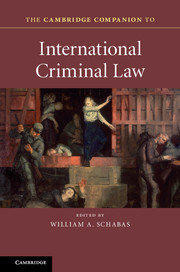Book contents
- Frontmatter
- Dedication
- Contents
- List of contributors
- List of abbreviations
- Introduction
- PART I PURPOSES AND PRINCIPLES
- PART II INSTITUTIONS
- 6 Ad hoc international criminal tribunals (Yugoslavia, Rwanda, Sierra Leone)
- 7 The International Criminal Court
- 8 National jurisdictions
- 9 The United Nations Security Council and international criminal justice
- PART III CRIMES
- PART IV TRIALS
- PART V THE FUTURE
- Index
- References
7 - The International Criminal Court
from PART II - INSTITUTIONS
Published online by Cambridge University Press: 05 December 2015
- Frontmatter
- Dedication
- Contents
- List of contributors
- List of abbreviations
- Introduction
- PART I PURPOSES AND PRINCIPLES
- PART II INSTITUTIONS
- 6 Ad hoc international criminal tribunals (Yugoslavia, Rwanda, Sierra Leone)
- 7 The International Criminal Court
- 8 National jurisdictions
- 9 The United Nations Security Council and international criminal justice
- PART III CRIMES
- PART IV TRIALS
- PART V THE FUTURE
- Index
- References
Summary
On 17 July 1998, a Statute for a new, permanent International Criminal Court was adopted at a Diplomatic Conference held in the city of Rome, in an emotional vote of 120 to seven, with twenty-one states abstaining. The vote was, for many, unexpected, for the road to the establishment of the Court had been long with many twists and turns along the way. Indeed, when the Diplomatic Conference opened on 15 June, it was unclear whether it would lead to a concrete outcome. Some seventeen years later, the Court now has 123 State Parties and has been in existence since July 2002. Permanent premises are nearing delivery, and several trials have been completed or are close to completion. This chapter will briefly explore the efforts that led to the establishment of the Court in 1998, outline the basic structure and operations of the Court as well as its current proceedings, and, finally, elaborate upon some of the challenges it faces as it proceeds through its second decade.
The road to Rome
The notion that a criminal court established by States could try individuals accused of committing crimes under international law was too radical for most statesmen – and even most scholars – in the early twentieth century. Although the Treaty of Versailles that followed the First World War provided that a ‘special tribunal’ would try William II of Hohenzollern for the ‘supreme offence against international morality and the sanctity of treaties’, the American members of the Commission on the Responsibility of the Authors of the War expressed reservations about the legality and the appropriateness of such an exercise, and the Netherlands refused to extradite Kaiser Wilhelm for trial. Following this disappointing precedent, in the 1920s, expert bodies, including the Committee of Jurists of the League of Nations, the International Association of Penal Law, and the International Law Association proposed the creation of a permanent international criminal court, but these proposals did not immediately bear fruit. Many experts concluded that the creation of a court to try individuals was an affront to state sovereignty, and to the ‘right’ to be judged under domestic law and by one's countrymen. They also argued that heads of State could not be liable to the international community but were accountable only to their own citizens, and noted that there was no international criminal code with which potential defendants could be charged.
- Type
- Chapter
- Information
- The Cambridge Companion to International Criminal Law , pp. 137 - 154Publisher: Cambridge University PressPrint publication year: 2016
References
- 2
- Cited by



